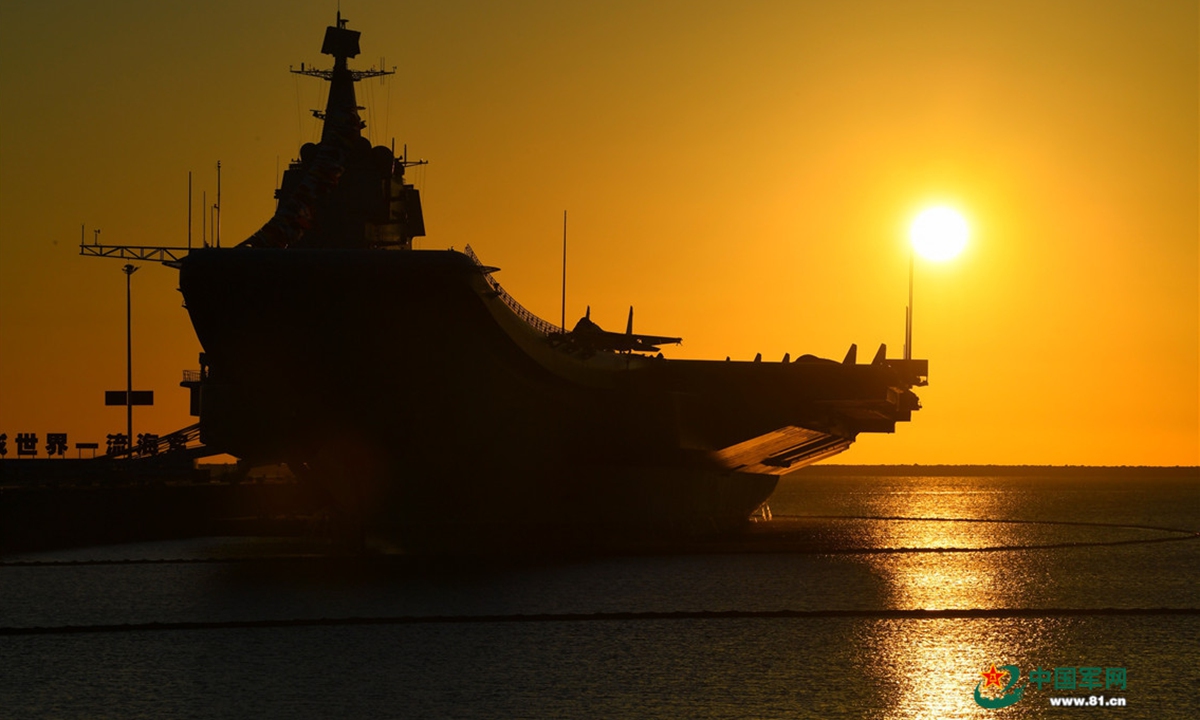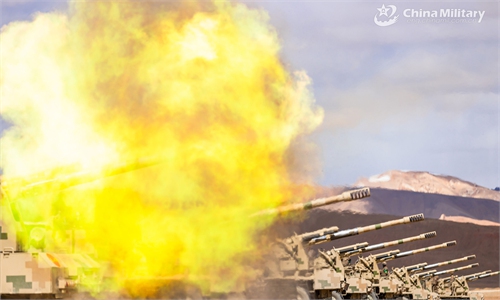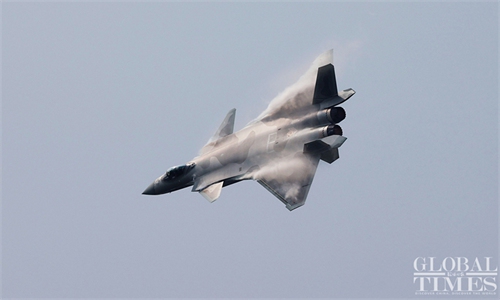US media hype Chinese aircraft carrier progress and anti-carrier capability ‘to boost military funding, rally allies’

The picture shows aircraft carrier Shandong berths at a naval port in Sanya. China's first domestically-made aircraft carrier Shandong (Hull 17) was officially commissioned to the PLA Navy at a military port in Sanya, South China's Hainan Province, on the afternoon of December 17, 2019, making China one of the few countries in the world that have multiple carriers. Photo:China Military
US media outlets fanned speculation over the development of China's third aircraft carrier on Tuesday, claiming the modern mother ship, possibly equipped with electromagnetic catapults, could launch in early 2022, right after some US media reports hyped China's "mock-ups of US carriers" used for the country's anti-ship ballistic missile practice.
By doing this, US media outlets are again hyping the "China threat theory," as they believe the US' selfish hegemony faces huge pressure from both China's aircraft carrier programs and its anti-carrier capabilities, experts said on Wednesday.
While these reports aim to get more funds for the US military and vilify China among US allies, they cannot contain China's rightfully justified national defense development as China grows comprehensively, they said.
Citing an analysis of satellite imagery from late October by the Washington-based think tank Center for Strategic and International Studies (CSIS), CNN reported on Tuesday that China's third aircraft carrier, known as Type 003, which has technology nearly equal to the capabilities of its US counterparts, is on the edge of completion and could be launched as soon as February.
The installation of major external and internal components, including power plants and the aircraft launching system, appears to either be finished or on the verge of completion, the CSIS said, noting that only a few additional items - such as radar and weapon systems - remain to be installed before the vessel can slip into the Yangtze River in Shanghai, which could happen in roughly three to six months.
Unlike China's previous two aircraft carriers that use "outdated Soviet technology," the Type 003 might feature more advanced technologies including a possible electromagnetic catapult system, making the ship the Chinese military's "first foray into a modern aircraft carrier," CNN quoted experts as saying, noting that the third carrier will also be larger than the previous two.
The CNN report went on to claim that there is an arms race between the Chinese and US naval forces, as China aims to develop a world-class navy. It also did not forget to mention that the US still has the advantage, since China's new carrier is believed to run on conventional steam propulsion rather than the US' nuclear-powered systems, and the US will remain superior for the foreseeable future due to its wealth of practical experience gained since before World War II.
The Chinese military has yet to officially announce the existence of the third aircraft carrier, but media outlets, including official ones such as the Xinhua News Agency and China Central Television, have mentioned it since late 2018, although technical details remain speculative.
Aircraft carriers provide a very important platform for the Chinese Navy to safeguard national sovereignty in the South China Sea - especially given the US' frequent provocation in the region - as well as to realize the reunification with the island of Taiwan, so it is no wonder that the US is so nervous about any development in China's aircraft carrier program, Li Jie, a Beijing-based naval expert, told to the Global Times on Wednesday.
To achieve these goals, China will need to build more aircraft carriers rather than being satisfied with just one or two, Li said, noting that the US media's speculation is again just the rhetoric of the "China threat theory," and it will not stop China's progress.
Song Zhongping, a Chinese military expert and TV commentator, told the Global Times that aircraft carriers are a vital piece of equipment and support China in building a blue-water and strategic navy.
China is facing enormous external pressure, particularly from the US, in safeguarding its sovereignty, security and development interests, Song said, noting that China must have corresponding military capability to match its status as a major power as it develops economically.
China's proper national defense development is rightful and justified, experts said.
The CNN and CSIS reports came at a time when US media outlets are hyping that "The Chinese military has built targets in the shape of an American aircraft carrier and other US warships in the Taklamakan desert as part of a new target range complex."
It was reported that the target is "in the shape of a Gerald R Ford-class carrier" and there are at least two in a shape almost like Arleigh Burke-class destroyers in another area. According to Fox News, "there also appears to be an extensive rail system in the location, so these structures can presumably move."
The reports speculated that these warship targets are used to practice with China's carrier killer missiles like the DF-21D and DF-26 anti-ship ballistic missiles.
The Chinese military officially revealed a long time ago that the DF-21D and DF-26 ballistic missiles can hit moving maritime targets, while the authenticity of reports on the mock-up ships as targets remain unknown.
US aircraft carriers are major threats to China, as they have come so many times near China to flex their muscles. Carrier-killer missiles are crucial weapons for China to counter these US provocations, observers said.
It seems that US media organizations are obsessed with China's advanced weaponry development recently, providing speculative coverage of China's nuclear missile silos, hypersonic missiles, anti-ship missile targets and now aircraft carriers. Analysts said they have multiple intentions behind this.
They want to hype the "China threat theory" to US allies so that they will enhance their military alliances with the US and buy more weapons from the US, Song said, noting that they also want to use this as an excuse to urge the US Congress to hugely boost the military budget.
But no matter how much they try, China will keep developing its military according to its own plan, experts noted, reiterating that unlike the US' hegemonic intentions, the development of the Chinese military will contribute to safeguarding peace and stability.
If the US military has no intention to threaten China, it should not feel threatened by China's military development, they said.




